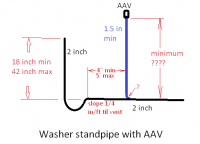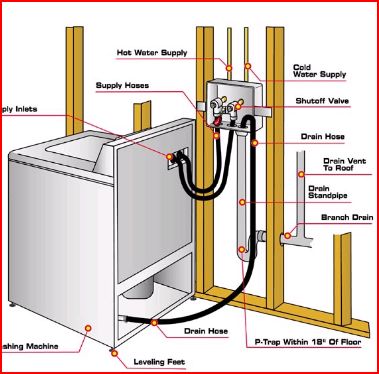tigeraid
New Member
Hey guys, first time poster, just moved to a new house, slowly fixing all the little things we've found.
I'm a little perplexed by the washing machine setup, as I've always had a laundry tub arrangement in the past. In this new house, the laundry room is a finished portion with the unfinished basement, and all the plumbing, directly behind it. Everything is above the main sewer line out EXCEPT the washer and dryer, because the main sewer is maybe 3 feet off the basement floor.
Excuse the awful doodle, but this should get the point across:

Now, when we originally moved in, the washer drain, using a big long extension, emptied into the 2" PVC pipe as shown in the sketch, which is sloped correctly. It joins a second sloped pipe, which in turn dumps into the main. However, the washer drain (the hook-shaped part) was just sort of shoved into the open end of the pipe, with a rubber sleeve limply holding it in place.
This setup would drip, occasionally. Coincidentally, we had a clog at the main not long after moving in, and the first place it flooded out of was where the dryer outlet sat. After fixing the clog me, being the super smart feller, thought that setup looked halfassed, so I got an adapter to go from the 1" washer drain to the 2" PVC, tightened her all up nicely, and done.
Now I browse around and see that, apparently, the washer drain is SUPPOSED to be loosely hanging in the 2" pipe, rather than tightened up? I'm guessing it's for air flow...
So basically, I'm questioning the setup, and what changes I should make. I wanna stress that everything appears to work GREAT, right now. There's no noticeable backwash in the washing machine, no bad smells, no leaks, and it all appears to drain correctly. But a) I don't have an air vent, at least not on this particular line... There are other ones elsewhere in this system... and b) There doesn't appear to be a P-Trap, which apparently it needs too?
There IS, however, another P-Trap, which I forgot to draw in my sketch, at the point where the kitchen drain and the washer drain meet the the main....
Thoughts? Thanks.
I'm a little perplexed by the washing machine setup, as I've always had a laundry tub arrangement in the past. In this new house, the laundry room is a finished portion with the unfinished basement, and all the plumbing, directly behind it. Everything is above the main sewer line out EXCEPT the washer and dryer, because the main sewer is maybe 3 feet off the basement floor.
Excuse the awful doodle, but this should get the point across:

Now, when we originally moved in, the washer drain, using a big long extension, emptied into the 2" PVC pipe as shown in the sketch, which is sloped correctly. It joins a second sloped pipe, which in turn dumps into the main. However, the washer drain (the hook-shaped part) was just sort of shoved into the open end of the pipe, with a rubber sleeve limply holding it in place.
This setup would drip, occasionally. Coincidentally, we had a clog at the main not long after moving in, and the first place it flooded out of was where the dryer outlet sat. After fixing the clog me, being the super smart feller, thought that setup looked halfassed, so I got an adapter to go from the 1" washer drain to the 2" PVC, tightened her all up nicely, and done.
Now I browse around and see that, apparently, the washer drain is SUPPOSED to be loosely hanging in the 2" pipe, rather than tightened up? I'm guessing it's for air flow...
So basically, I'm questioning the setup, and what changes I should make. I wanna stress that everything appears to work GREAT, right now. There's no noticeable backwash in the washing machine, no bad smells, no leaks, and it all appears to drain correctly. But a) I don't have an air vent, at least not on this particular line... There are other ones elsewhere in this system... and b) There doesn't appear to be a P-Trap, which apparently it needs too?
There IS, however, another P-Trap, which I forgot to draw in my sketch, at the point where the kitchen drain and the washer drain meet the the main....
Thoughts? Thanks.




